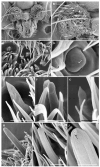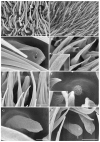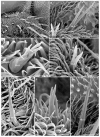Sensillar Ultrastructure of the Antennae and Maxillary Palps of the Warble Fly Oestromyia leporina (Pallas, 1778) (Diptera: Oestridae)
- PMID: 39194779
- PMCID: PMC11354788
- DOI: 10.3390/insects15080574
Sensillar Ultrastructure of the Antennae and Maxillary Palps of the Warble Fly Oestromyia leporina (Pallas, 1778) (Diptera: Oestridae)
Abstract
Despite the development of molecular techniques, morphological phylogeny still remains integral in underpinning the relationship between some clades of Calyptratae, especially the ones with fast radiation, such as those in Oestridae (Diptera: Brachycera), yet few synapomorphy has been proposed for adults in this family. Using scanning electron microscopy, we investigated the morphological structure and ultrastructure of the antennae and maxillary palps of adult Oestromyia leporina (Hypodermatinae, Oestridae). One type of trichoid sensillum (Tr), three types of basiconic sensilla (Ba I, Ba II, and Ba III), one type of coeloconic sensillum (Co I), and one type of clavate sensillum (Cl) were found on the antennal postpedicel. Surprisingly, this species has the most complex types of sensilla on the maxillary palps that have been reported in Calyptratae so far, with two types of coeloconic sensilla (Co II and Co III) and two types of mechanoreceptors. We then identified three common characteristics on the arista of Oestridae (Hypodermatinae, Oestrinae, Gasterophilinae and Cuterebrinae) that are potential synapomorphies. These characteristics indicate the value of the morphology of maxillary palps and aristae in taxonomy studies of Calyptratae.
Keywords: Oestromyia leporina; antenna; maxillary palps; morphology; sensilla; sensory pits; ultrastructure.
Conflict of interest statement
The authors declare no conflicts of interest.
Figures






References
-
- Kutty S.N., Pape T., Wiegmann B.M., Meier R. Molecular phylogeny of the Calyptratae (Diptera: Cyclorrhapha) with an emphasis on the superfamily Oestroidea and the position of Mystacinobiidae and McAlpine’s fly. Syst. Entomol. 2010;35:614–635. doi: 10.1111/j.1365-3113.2010.00536.x. - DOI
-
- Yan L.P., Pape T., Elgar M., Gao Y.Y., Zhang D. Evolutionary history of stomach bot flies in the light of mitogenomics. Syst. Entomol. 2019;44:797–809. doi: 10.1111/syen.12356. - DOI
Grants and funding
LinkOut - more resources
Full Text Sources

